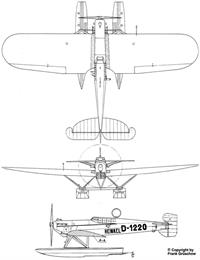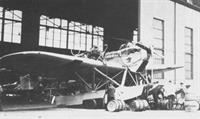A relatively large long-range aircraft, the He 6 bore many features of the earlier Heinkel seaplane monoplanes, but accomodated its crew of three to four in an enclosed cockpit. Crew generally comprised a pilot, navigator and radio operator, and reconnaissance was again to be the task of this seaplane. One example, D-1220 (c/n.286)*, attempted to reach Newfoundland in Autumn 1927, via Lisbon and the Azores. It departed from Warnemunde on October 12 but on the 13th of the following month**, it capsized off the Azores and could proceed no further.







| Type |
3-seat experimental designed for Atlantic crossing |
| Engine |
a 1 BMW VIa |
b 1 Packard 3A-2500 with a 4-bladed prop. |
| Dimensions |
Length 13,18 m, height 4,65 m, span 18,20 m, wing span 60,93 m2 |
| Weights |
Empty , loaded , max. take off weight |
Empty 2800 kg, loaded 6000 kg. Fuel 4320 l in two wing-tanks and one
fuselage tank |
| Performance |
Max.. speed , cruising speed , range , endurance , service ceiling , climb |
Max. speed 205 km/h at sea level, cruising speed 170 km/h, range 4000 km, service ceiling 2300 m, climb to 1000 m 14,0 min., endurance 23 h |
| Type |
Werk.Nr |
Registration |
History |
| a |
286 |
D-1220 |
First flight 2/8 1927 at Warnemünde. With a BMW VIa engine, not enough reliable and too low power.for the long flight. |
| b |
286 |
D-1220 |
The a modified with a Packard engine lent from Severa GmbH. .During trials the floats were enlarged with a second step and the forward struts became longer. The trials ended with a record flight ( 11 hours with a payload of 1000 kg). Then came the record attempt in 1927
12.10 take off Warnemünde 12:21H, landed Brunsbüttel 14.20H
13.10 take off Brunsbüttel 09:34H and landed Wilhelmshaven 10:18H
14.10 take off Wilhelmshaven 10:58H and landed Amsterdam 13:02H
16.10 take off Amsterdam 08:05H and landed Vigo 16.00H
18.10 take off Vigo 06:05H and landed Lisbon 08:55H
04.11 take off Lisbon 04:25H and landed Horta, the Azores 14:10H
13.11 take off Horta 02:33H but forcelanded following its third take off attempt and due to the heavy swelling
overturned. Besides the two crew already mentioned there was also a Packard engine engineer onboard, Rohde. All three were rescued unharmed but the aircraft was a complete write off. Nothing known about the wreck, but most probably scrapped in some local scrapyard... |
In the 1920s many aviators attempted the venture to cross the Atlantic even if they lost their lives when on 21 May 1927, after a flight of 33 hours and 30 minutes, Charles Lindbergh made the venture from New York to Paris. The most difficult task on the contrary still remained to be done, since the winds on the Atlantic were mainly blowing from east to west. 11 months later Koehl von Hünefeld und Fitzmaurice performed the business on a Junkers W 33.
In 1927 the construction of this aircraft was presented as a private initiative by Ernst Heinkel but in reality behind it were the Reichsmarine and the Hamburg-America Line. The naval command had requested the Lorenz and Telefunken companies to develop radios for aircraft destined for the enterprise but the involvement of the military, as the development and construction of military aircraft was forbidden to the Germans according to the terms of the Treaty of Versailles.
The Hamburg-America Line ( HAPAG ) was one of the largest shipping companies in the world based in Hamburg. It had developed in the second half of the 1920s and was rather interested in aviation to the point of having established a special section "Luftfahrt" (aviation). HAPAG financed two projects:
an all-metal trimotor seaplane, Junkers G 24h1e (serial number 923), of the Swedish subsidiary "AB Flygindustri" of Junkers based in Linhamn taken Malmö. The plane was nicknamed "Taube" (pigeon).
the HE 6 (c/n 286, regn. D-1220) of a more traditional setting as it was constructed of wood and canvas steel tubes. The plane was a further development of the Hansa-Brandenburg W.29 designed by Ernst Heinkel himself in 1918. The plane was nicknamed "Schwalbe" (swallow).
While the G 24 remained the property of Junkers Flugzeug- und Motorenwerke AG, the HE 6 passed to HAPAG for around 120,000 marks (engine excluded). HAPAG also assumed other costs such as insurance, fuel, personnel, organization with 245,000 and 180,000 marks respectively for the G 24 and the HE 6.
